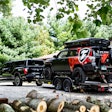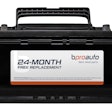 Bandag’s latest trailer retread, the TR4-1, offers plenty of savings and company-backed performance.
Bandag’s latest trailer retread, the TR4-1, offers plenty of savings and company-backed performance.Bridgestone Commercial, a division of Bridgestone Americas Tire Operations, announced Tuesday its new Bandag TR4.1 trailer retread.
According to Bridgestone, the TR4.1 retread provides affordable and dependable wear life performance for small to medium truckload, less-than-truckload (LTL) and pickup and delivery (P&D) fleets.
“When shopping for trailer tread options, fleets often have to choose between low cost and functionality,” said Ben Rosenblum, director of Bandag Marketing, Bridgestone Commercial.
“The TR4.1 retread rounds out the Bandag portfolio line for trailer applications, offering a balance of price and performance.”
The Bandag TR4.1 retread features include a smooth and continuous shoulder to promote uniform wear; a patented retread process and compound for long wear; circumferential grooves to evacuate water and improve traction in wet conditions; and diagonal tread block edges to enhance traction on wet and dry surfaces.
The TR4.1 retread from Bandag accommodates most casing sizes used in small to medium truckload, LTL and P&D service. It is now available through Bandag dealers in the U.S. and Canada.
According to Bandag, retreads result in a 30 to 50 percent savings over new tires. The retreading process recycles the majority of the tire and, according to Bandag, uses seven gallons of oil to manufacture, compared to 22 gallons required for a new a tire.
Like other retread companies, Bandag remains active in educating consumers about changes in retread technology which have improved performance and reliability.
On its website, Bandag refutes criticism that retreads are not a safe alternative to new tires. It states that school bus fleets and jet fighter planes use retreads.
In an online brochure titled, “Busting the Myths about Retreading,” Bandag reports, “Nearly 80 percent of all aircraft tires now in service in the United States are retreads, according to the Tire Retread & Repair Information Bureau.”
Regarding tire shards found along the road, Bandag reports that those remains are usually not retreads. The company states that any tire remains with casing wire indicate that the tire is not a retread, since casing wire is not used in the retread process.
Bandag is confident about beating the competition. Through the Bandag Challenge, the company guarantees a greater savings through their retreads or they’ll refund the difference.










